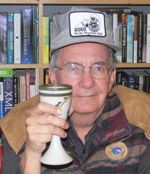

Daley Train Log
Page 29
I can divide the day into two sessions. In the early afternoon I visited the Model Baron hobby store and bought 6 manual turnouts as well as a few pieces of track and a small bottle of red paint. The track and turnouts allowed me to complete the track layout (I still have to nail down track in Black Diamond, Coaldale and Lennox). I put the first coat of red paint on the three water barrels that will be placed on the wooden trestle. The barrels are to put out a fire on the trestle! I can now focus on getting my trains operational.
The second session was after dinner. The goal is to have a train of at least 4 cars that is fully operational on any part of the layout. This is a difficult goal as all of the cars must be in perfect running order and each of the track joins and turnouts needs to be very smooth. This is much more like a Swiss watch than one realizes. There is very little room for variation in any of the standards.
I decided to begin with the first four cars that I put together in 1988. That is exactly 20 years ago! The first objective was to ensure that each car had excellent rolling properties. This meant that it would roll down a 2 degree slope with out any assist.
CN 524270, a 40' boxcar originally built in 1956, met this requirement without any modifications. I then checked the couplers for height and operation. Perfect.
CN 78213, a caboose originally built in 1929, failed the requirement. I decided to replace both the trucks and the wheels. The wheels were non-magnetic Kadee 520 33" diameter wheels. I am not sure about the truck but the wheels ran very smoothly in it.
Replacing the truck required me to resort to my hobby building skills (which, admittedly are a little rusty). I was able to pry the original truck off the frame with a screwdriver. I then whittled a short length of plastic tubing to fill in the hole that the post of the original truck fit into. I then noticed a small screw that came with the turnouts was the right size to twist into this tubing. This overall operation was a total success.
The couplers were fine for height and operation. I now had two cars that were ready for an operational test.
CN 123411, a black gondola car - the prototype was built in 1949. This car met the rolling criteria but I spent some time cleaning the gunk off the wheels.
CN 473966, a 40' boxcar originally built in 1946. This car also needed a complete replacement of the trucks and wheels. This time I used Kadee 524 28" diameter wheels.
This involved the same approach as with the caboose. However the coupler was too low at one end. I added 3 washers to the screw holding the trucks and this raised the coupler the necessary amount.
I now have four cars (2 boxcars, a gondola car and a caboose), all from the steam era, that have excellent rolling characteristics.
The next step was to see what happens when they are pulled by a locomotive. I had a couple of derailments as soon as the cars went over the first turnout. I tried loosening the screw holding the trucks to give the wheels a little more flexibility. This seemed to help a bit. But I have yet to have a smooth run over Route 1. There are two different problems. Sometimes one of the cars derails and sometimes the cars uncouple. I now need to pay very close attention to what happens as the train moves along the route. Sometime the problem may be due to one particular car. The other possibility is a problem with the track or a turnout. I am determined to continue these diagnostic runs until I am very confident that there will be no operational problems.
Each session took about 2 hours.